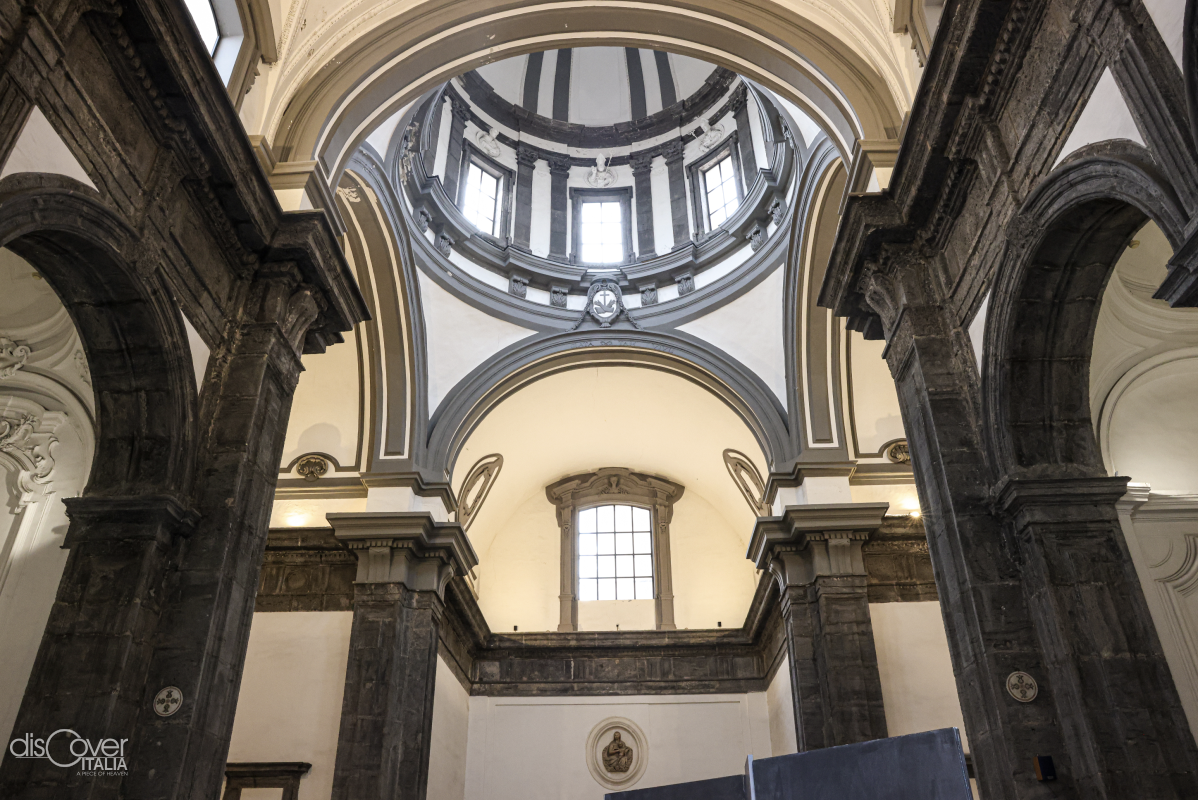Walking down the bustling Via Duomo is the church of San Severo al Pendino, adjacent to Palazzo Cuomo.
 It was built in 1448 to replace the ruins of the earlier church of Santa Maria a Selice at the behest of Pietro Caracciolo, abbot of the nearby basilica of San Giorgio Maggiore, who had also built a hospital there. In 1575 the church passed to the Dominican friars, who in 1599 entrusted the renovation project to Giovan Giacomo di Conforto, an architect who trained in the phase of transition of Neapolitan architecture from the Renaissance to the Baroque, between the late 16th and early 17th centuries. The latter united the church with the monastery, built near Palazzo Cuomo, and overall gave a late Mannerist appearance to the entire church. During the first half of the 18th century, the church underwent significant Baroque remodeling, such as the fine balustrade carved in piperno, one of the most widely used materials in sacred building in Naples.
It was built in 1448 to replace the ruins of the earlier church of Santa Maria a Selice at the behest of Pietro Caracciolo, abbot of the nearby basilica of San Giorgio Maggiore, who had also built a hospital there. In 1575 the church passed to the Dominican friars, who in 1599 entrusted the renovation project to Giovan Giacomo di Conforto, an architect who trained in the phase of transition of Neapolitan architecture from the Renaissance to the Baroque, between the late 16th and early 17th centuries. The latter united the church with the monastery, built near Palazzo Cuomo, and overall gave a late Mannerist appearance to the entire church. During the first half of the 18th century, the church underwent significant Baroque remodeling, such as the fine balustrade carved in piperno, one of the most widely used materials in sacred building in Naples.
In the French decade (between 1806 and 1815) the Dominicans were removed from the city and the church became the seat of the State Archives until 1835, when the archives passed into the Monastery of Saints Severinus and Sossio. Only later did the church return to the hands of the religious, in this case the Friars Minor Observant who, in turn, were removed from Naples in 1863. During the Restoration, the church of San Severo al Pendino was stripped of its Baroque facade for one of neo-Renaissance style, and the street level was raised several meters. The building was also downsized, the first two side chapels with their attendant works being demolished, while the convent complex was totally demolished.
During World War II, the church was used as an air raid shelter, while in 1980 it was severely damaged by the earthquake that famously destroyed many Neapolitan churches and buildings. After the earthquake, several restoration and safety works followed. The most important interventions, in particular, concerned the 18th-century polychrome marble altars, whose fragments scattered throughout the church were skillfully reassembled according to their original appearance.
The church of San Severo al Pendino today turns out to be deconsecrated and is open to the public as an exhibition space thanks to the Department of Culture and Tourism of the City of Naples. Often, during the Christmas period, exhibitions of nativity scenes are held with the aim of making the great Neapolitan nativity art accessible to all, residents and tourists alike.
The facade of the church is very austere having lost the Baroque features that characterized it in the past. Today we can see a simple portal with two side niches, while a rose window is appreciated at the top. The interior, with a Greek-cross plan, is rather austere, and the predominant colors are unmistakably white and gray, brought back to life after the restoration that eliminated 19th-century interventions. For elegance and polychromy, the sumptuous 18th-century altars stand out. The 17th-century dome covers the central part of the building and is the work of architect Giovan Giacomo di Conforto, who played a leading role in the church's construction. The most important work in the church of San Severo al Pendino is undoubtedly the sepulchral monument of Giovanni Alfonso Bisvallo, sculpted by Girolamo D'Auria in 1617. Other important works of note in the church are a canvas by Luca Giordano depicting religious themes and a relief terracotta by Girolamo D'Auria himself depicting Santa Maria a Salice.
The church of San Severo al Pendino, despite being deconsecrated, is configured as a site of considerable historical and artistic importance and, to this day, is a gathering point thanks to the events, exhibitions, conferences and meetings held there.



Comments powered by CComment